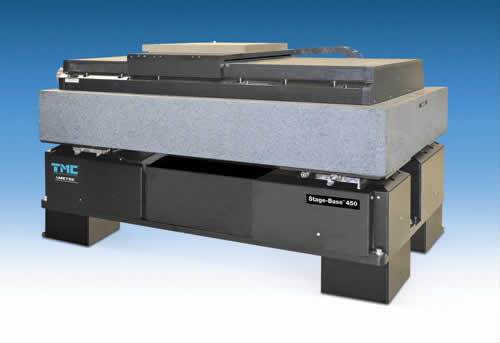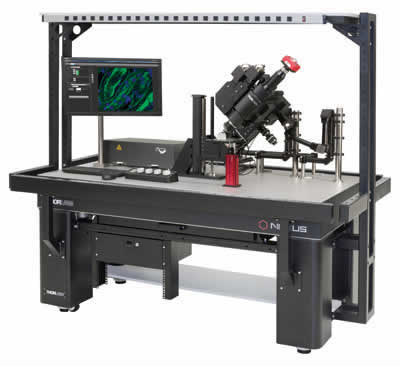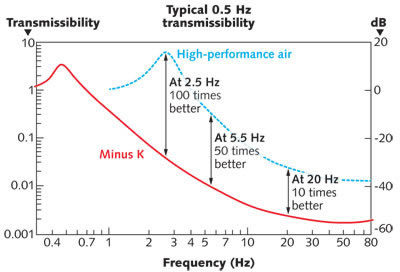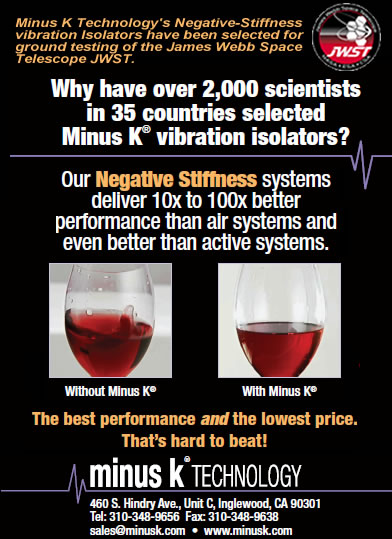
Laser Focus World - March 2015
Photonics Products: Vibration-Isolation Tables: Isolation tables support stable optical setups
Essential for many experiments in optics, the vibration-isolation table comes in many forms, including active and passive vibration isolation, as well as pneumatic and non-pneumatic versions.
By John Wallace, Senior Editor
At the core of many an experimental optics setup is a vibration-isolation table—that familiar thick metal-topped table with a square array of screw holes (often on a 1 in. center) and which, if pneumatically isolated, hisses when you lean on it as it tries to restabilize. Such tables come in many sizes, types, and thicknesses, with either passive or active isolation approaches. Some vibration-isolation tables forgo pneumatic isolation altogether, requiring no air supply at all.
Although some small isolation tables have relatively thin steel or granite tops, the type of table most familiar to optical engineers who need excellent experimental stability has a thick top in which a metal honeycomb is sandwiched between steel top and bottom plates. The honeycomb is light in weight but, just as important, helps damp vibrations. Another approach, which consists of a combination of pneumatic and/or active isolation with a thick, solid granite table, is aided in stability by the large mass of the table, which lowers the system's natural (resonance) frequency.
Small vibration-isolation workstations are used, for example, by those who manage high-power microscopes and want a very stable image. Larger isolation tables, which are employed widely in both industrial and academic optics labs, are indispensable for everything from finicky ultrafast laser research setups to semiconductor-chip manufacturing equipment. In addition, the convenience of the square array of screw holes in many isolation tabletops allows the engineer to quickly bring an idea to life in the lab to see if indeed the idea is worthwhile.
Passive vibration isolation is achieved by the use of springs and damping material or pneumatic isolation, or both. Active vibration isolation (also known as vibration cancellation) adds vibration sensors and vibration-compensating actuators such as voice coils (in a sense serving as a high-tech version of noise-canceling headphones).
Quick stage settling for the semi industry
An example of an isolation table that combines a massive granite top with active vibration and motion cancellation is the Stage-Base 450 vibration-isolation system (see Fig. 1) recently introduced by TMC Ametek (Peabody, MA; TMC also makes the types of isolation tables normally found in optics labs). The system is designed to control building floor vibration in semiconductor facilities and is specifically intended to be the primary vibration cancellation system for semiconductor tools that incorporate high-precision motorized x-y stages (for example, lithographic wafer steppers for computer-chip manufacture and similar tools for display manufacture).

FIGURE 1. A large, massive Stage-Base vibration-isolation system from TMC is an example of the technology needed to satisfy the requirements for manufacturing precision and speed in the semiconductor industry.(Courtesy of TMC)
The minimum feature size on today's computer chips has reached down to 14 nm, meaning that the photolithographic exposures that create the patterns on a silicon wafer for these chips must be aligned and stable to a small fraction of this amount. While this is an extreme example, tight alignment and other translation-stage requirements are rife throughout the semiconductor industry; thus, vibration isolation is essential to maintain a high wafer-processing throughput.
While such tools require extremely efficient vibration isolation, they just as critically require that payload motion induced by the moving stage settle very quickly to maximize tool throughput. To reduce settling time, TMC added voice-coil motor technology with feed-forward control to its STACIS system, which is based on an active piezoelectric vibration cancellation system. The system, which has a patent pending, provides a fourfold improvement in settling time over TMC's previous generation STACIS iX Stage-Base.
The system provides active floor vibration cancellation starting at 0.6 Hz increasing to a 10-to-1 reduction by 2 Hz, notes Wes Wigglesworth, product manager of active systems at TMC. (Such low-frequency vibrations are difficult to control due to the fact they tend to be near an isolation system's natural frequency; at the same time, for quick stage settling, they must be well controlled.)
The archetypal optical table
Ask any optical engineer to describe a typical vibration-isolation table and he or she might say something like, "Well, it has four thick pneumatic legs, plastic air hoses here and there underneath, a stainless-steel top with lots of holes, and … oh, yes—the sides are painted black." One line carrying this well-known color theme is the Nexus line, made by Thorlabs (Newton, NJ).
These tables "provide a durable, rigid, working surface on which optics can be mounted and aligned with long-term stability," says Buki Dada, marketing manager at Thorlabs. The isolation tables are offered in 8.3 in. (210 mm) or 12.2 in. (310 mm) thick versions, with damping optimized for each table size.
The tables have all-steel construction, high thermal stability, broadband damping, and a precision-machined matte finish, Dada notes. The steel honeycomb core extends from top to bottom skin without intermediate structures that reduce the overall stiffness. The tables are available with or without sealing cups (which, if requested, are placed beneath each individual screw hole to prevent fluids, such as an optical engineer's coffee, from dripping down into the table's innards). Each table is tested and shipped with its own test data certificate and compliance curve (which details the dynamic response of the table to vibration) to provide accurate and size-specific data.
The tables are often paired with Thorlabs' active-isolation workstations to create modular, mobile labs for imaging applications requiring submicron resolution, says Dada. Various shelving options and other accessories can be placed around the imaging system, allowing supporting equipment to be in proximity to the isolated working surface without being in contact with it (see Fig. 2).

FIGURE 2. A Thorlabs optical table and workstation is shown supporting the Thorlabs Pergamon II Series multiphoton microscope system, a femtosecond-laser source, and a computer. (Courtesy of Thorlabs)
Different versions, different uses
While some facilities need high-performance vibration-isolation tables, others don't. Recognizing this, Newport Corp. (Irvine, CA) makes three lines of tables to serve varying needs. The SmartTable, the company's top-model table, is an actively damped optical-table system with rigid or pneumatic isolators, with damping optimized for different payload/load distribution situations, according to Sylvia Tan, vibration-control product marketing manager at Newport. The approach is much more effective than broadband damping and targets all the resonances in typical frequency ranges (for example, 100 Hz to 500 Hz); its pneumatic isolators have large volume chambers and laminar-flow disks to ensure smooth and high-quality isolation performance.
The Research Series tables differ from the SmartTables in that they do not have active damping, but instead rely on a tuned damped vibration-isolation system with rigid or pneumatic isolators. "The precisely tuned dampers maximize the damping performance by targeting the most prominent resonance peaks," says Tan. Finally, a broadband-damped optical table system, also available with rigid or pneumatic isolators, is the most economical version. "Advanced manufacturing methods maintain table flatness and vertically bonded cores with a triple-core interface boost tabletop stiffness and damp/absorb vibrations in a broadband range," notes Tan.
The high-performance SmartTable, which includes two or three electronic dampers that actively sense the vibration and emit precisely phased signals to cancel it out, is used for demanding tasks such as atomic-force microscopy (AFM), scanning-probe microscopy (SPM), live-cell imaging, low-energy optoelectronic, and other sensitive applications that require a long optical exposure time and high resolution and repeatability.
Broadband damping techniques can only uniformly reduce vibration energy and do not know at which frequency the table is undergoing a resonance, explains Tan. Active dampers together with their controllers not only sense these resonances, but also automatically tune themselves in order to cancel those resonances in real time: "all plug and play, easy to use," says Tan. The system also includes software that continuously gathers vibration data on the tabletop and monitors the experimental conditions.
In one experiment carried out using a SmartTable, Steven Koo, a research engineer at the Institute for Soldier Biotechnologies at the Massachusetts Institute of Technology (MIT; Cambridge), was investigating various structural designs for periodic nanostructures. The investigation included the fabrication of these structures. A particular nanostructure design was fabricated and imaged on a vibration-isolated optical table. Figure 3a is from a structure built and imaged with the table's active dampers disabled; the resulting vibration created a pattern of defects in the construction and also deleteriously affected the image contrast and focus. Figure 3b shows the same material and construction method, but created with the SmartTable active dampers enabled.

FIGURE 3. In a nanostructure fabrication and imaging experiment carried out by Steven Koo of MIT on a Newport SmartTable, results are shown for two attempts, one without (a) and the other with (b) the active damping enabled. (Courtesy of Newport)
"These images show the results of a multibeam-interference lithography setup with and without the smart table active," says Koo. "These images come from a four-beam exposure. We have a continuous-wave 532 nm diode laser that we split into four beams and control the relative intensity, polarization, and angle of intersection of the four beams as we recombine them at our sample. The sample is a photoresist material like SU8. The 3D interference pattern is transferred into photoresist during exposure and after developing we are left with a 3D structured polymer." The exposure times can be relatively long (minutes) so any vibrational noise during an exposure can cause a degradation in the structure, he notes.
"Our lithography setup is on the fifth floor of a relatively noisy building, so the active vibration damping helps us a lot," he says. "Before we had the table, we could only get acceptable results by waiting until late in the evening to do exposures when the building was quieter."
No pneumatics needed
Minus K Technology (Inglewood, CA) manufactures totally passive, negative-stiffness vibration isolators. The isolators use no air and no electricity-just springs and flexures. Such an approach offers several benefits over traditional pneumatic tables, says Steve Varma, operations manager at Minus K.
"First, there is no need to have a compressed-air line plumbed in to your lab," he explains. "And, if you do not have an air line, you do not have to deal with nuisance compressed air tanks or noisy compressors. You also do not have to deal with electricity. Also, the negative-stiffness benchtop isolators are much lighter than traditional air tables. Negative-stiffness isolation systems achieve 0.5 Hz resonant frequencies that give literally 10 to 100 times better isolation performance than pneumatic tables, as shown by the transmissibility curve (see Fig. 4). And negative-stiffness isolation tables provide significant improvements in image clarity compared with pneumatic tables because of their significantly better isolation performance."

FIGURE 4. A transmissibility curve shows the performance of a Minus K table (red line) versus a pneumatically isolated table (gray dotted line). (Courtesy of Minus K)
While Minus K's MK-26 workstation/table looks a lot like a traditional air table, it actually uses negative-stiffness isolators in place of the pneumatic legs. Standard sizes include 30 × 36 in. with payload ranges from 52–142 lb to 783–943 lb, and 36 × 48 in. with payload ranges from 0–86 lb to 706–866 lb. A larger version, the MK-52, can handle larger and heavier loads.
Experimenters can place open optical components on these tables for applications such as interferometry, holography, and so on, says Varma. Single microscopes can also be placed on them. "The 0.5 Hz performance these isolators deliver allow the most complex of optical systems to perform at their best, even in adverse environments, such as upper floors of buildings where traditional air tables sometimes have difficulty due to their higher resonant frequencies," notes Varma.
Researchers at the optical spectroscopy laboratory at the University of Amsterdam (Netherlands), led by Erik van Heumen, are using Minus K's larger MK-52 table, along with a home-built cryostat, to keep their Fourier-transform (FT) optical-spectroscopy setup stable. The FT technique allows the researchers to interrogate the electronic structure of solids and their qualities (such as high-temperature superconductivity) using a broadband interferometric detection scheme to resolve spectral features in the frequency-dependent optical reflection and transmission coefficients of the material under investigation. Accurately detecting minute changes in the optical response near such phase transitions requires an ultra-high stability setup.
Optimized vibration isolation is essential, particularly in the very far-infrared range of the light spectrum where the noise in the bolometer detectors used is dominated by acoustical vibrations. The MK-52 optical table provides signal-to-noise ratios on the order of 100. In addition, the group's home-built cryostat ensures that the position of the sample with respect to the probe beam is stable as temperature is changed, thus eliminating systematic errors in the determination of the temperature dependence of the optical properties. The combination has enabled the Amsterdam group to detect the minute (less than 0.5 %) increase in reflection that takes place at the transition to the superconducting state of an iron-pnictide high-temperature superconductor.
Custom tables
It should be noted that many manufacturers of isolation tables, including all those in this article, are adept at designing and creating custom systems when needed. Such systems can differ in height, thickness, size and shape, table material, hole patterns, damping characteristics, and other qualities. If desired, the table sides could even be painted a color other than black.
 >
>